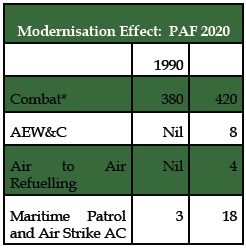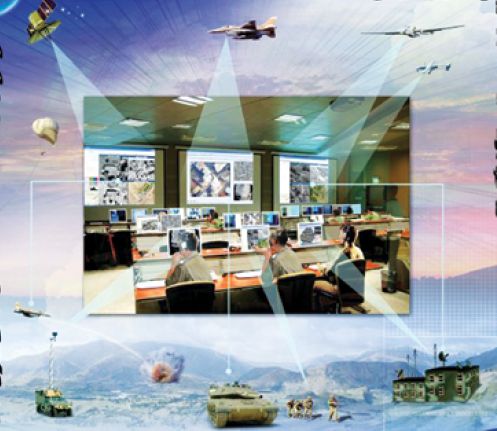China (besides France) continued to be a major source of PAF weapons and this increased after the US arms embargo in 1990. About 90 A‑5s were obtained in 1983–84 for the price of US$ 1 million per aircraft. Procurement of around 95 F‑7 series aircraft was done adding to the quantitative element in the PAF.
American military and economic aid came to a halt following the sanctions in 1990. The sanctions were highly damaging in nature as they not only suspended the US military aid and assistance but the procurement of essential spares was also blocked. The Brown amendment in 1995 permitted taking possession of the military equipment frozen in the United States, with the exception of nuclear capable F‑16 combat aircraft. The decade of 1990s was a setback for PAF modernisation due to the American sanctions and also Pakistan’s crippling economy. Economic growth recorded a steep decline and Pakistan was under severe pressure from the international financial institutions to cut down the spending on defence. Despite the US sanctions, low GDP and a collapsed democratic structure, Pakistan tried hard to acquire the air force equipment. Ayesha Siddiqua Agha states that in 1990, 50 Mirage‑3 were acquired from Australia for a paltry sum of US$ 28 million along with engines and spares. These Mirages were apparently retired from the RAAF and most of them had about a hundred flying hours remaining on their airframes.
Pakistan’s nuclear test in 1998 followed by General Musharraf’s military coup a year later led to further US sanctions laying further restrictions on acquiring high technology weapons from the West. The result was China’s pre-eminence in Pakistan’s arms imports.
Sino-Pakistan defence collaboration flourished under the umbrella of the US sanctions. While the K‑8 jet trainer has been under production at the Pakistan Aeronautical Complex, China and Pakistan entered into deal for the co-development of a fourth generation fighter aircraft, the JF-17 (earlier called the FC‑1). The JF-17 is designated to be a low cost combat aircraft to meet the tactical and strategic requirements of the Pakistan Air force with the reduced reliance of Pakistan on imports. The JF-17 is co-developed by Pakistan and China and is being built by China’s Chengdu Aircraft Industry Corporation (CAC) and Pakistan Aeronautical Complex (PAC). Pakistan has increased its initial target of buying 150 JF-17s to acquiring up to 250 aircraft. The PAF inventory currently possesses 16 JF-17s. Interestingly, beginning of May this year, immediately after Osama bin Laden’s killing in Pakistan’s high security military compound of Abbottabad, China announced the decision to deliver 50 JF-17s free of cost to Pakistan, by the end of 2011. This represents a quantum jump in Pakistan aircraft industry. Deal for two squadrons of Chinese J‑10 has been finalised and the deliveries are scheduled in 2014–2015. China has also confirmed the sale of six ship-based medium sized Z 9C helicopters to the Pakistan Navy.
Consistent demands for high technology weapons clearly indicate the modernisation of the Pakistan Air Force and Naval air, even more than the Army and Navy which implies that they expect the Air Force to play a major role in any future conflict.
Inflow from the US has been at a rapid pace post 9/11. Although the initial US supplies to Pakistan consisted of items like UH-II utility helicopters, VHF/UHF aircraft radios, air traffic control radars, night vision equipment and other equipment and support systems including intelligence gathering devices, Pakistan did receive major US equipment boasting the capabilities of the PAF. Pakistan did receive the F‑16s including the 12 F‑16 C/D Block 52 (6 more on order). The other important PAF acquisitions include C‑130E Hercules Transport aircraft and air surveillance radars — AN/TPS-77 and L‑88 LASS.
On the Naval Aviation front Pakistan received 8 P‑3C Orion Maritime patrol aircraft. Out of which 2 were destroyed in the terrorist attack carried on at Mehran Naval Airbase, on May 22, 2011. It is important to note that Pakistan’s Non-NATO Ally status allows the sale of used US weapons well below their depreciated value. For example the F‑16s supplied to Pakistan in 2005 with the original unit acquisition value of US$ 16.2 million have been transferred at a current unit value of US$ 6.48 million. The eight P‑3 aircraft were delivered free of cost to Pakistan in 2006. Deal for 100 Harpoon anti-ship missiles for the P‑3Cs was also finalised.
With the uncertainty related to the inflow of the US equipment owing to the experience in the past and increasingly strained relationship between the two countries, Pakistan has been aggressive in diversifying its sources of weapons supply. A deal for the purchase of 40 Mirage interceptor / ground attack aircraft from Turkey was finalised in 2004. The aircraft will be used as spares for the PAF’s existing fleet of Mirages. The Grifo‑7 radar from Italy, designed to improve air to air and air to ground performances is produced with the objective of equipping 46 F‑7 PG aircraft with the radar, together with approximately 45 Mirage IIIOs
Pakistan has focused on building force multipliers in the last decade. Pakistan entered into the procurement of airborne early warning systems from Sweden and China. In 2005, Pakistan entered into a deal with Sweden for the purchase of 4 SAAB-2000 turboprop aircraft equipped with Erieye Airborne Early Warning and Control systems (AEW&C). The negotiations for purchase of Chinese built airborne early warning aircraft – ZDK-03 have been finalised. Pakistan is the first country to buy the Chinese airborne early warning aircraft. 2 SAAB turboprop Erieye and 1 ZDK-03 have been delivered to the PAF. Airborne Early Warning would certainly be an additional asset for offensive air strikes at sea. Deal for 4 aerial refuellers from Ukraine has been finalised. The Il-78 will give the PAF its first airborne refuelling capability. Once operational these will be used to refuel Mirage III, F‑16s and eventually JF-17s. Acquisition of the aerial refuelling would provide extended range and deployment radius.
The PAF capability would increase significantly by 2020 as seen in the table below:
 |
*It is interesting to note that the combat number in the table does not give the true picture. Out of the total combat aircraft in 1990 just around 10 per cent were fourth generation. But by 2020 more than 90 per cent would be fourth generation aircraft in the PAF inventory.
Pakistan’s growing defence cooperation with China and support from the United States has been a major factor contributing in the modernisation of the PAF in the last nine years. The US sanctions in the 1960s and then in the 1990s not only gave space for Chinese and French defence equipment in the Pakistani market but also, Pakistan made concerted efforts towards defence production which has provided an exposure to Pakistan defence industry in the international market. The defence exports are estimated to increase to US$ 1 billion in the next 10 years.
Conclusions
To sum up following conclusions can be drawn based on the publicly known information and analysis of trends in the current phase of modernisation of the Pakistan Air Force:
1. Pakistan Air Force is engaged in a massive modernisation since 1990 (boosted after 9/11) both qualitatively and quantitatively. The thinking, writing and arms procurement in Pakistan indicates the historical consistency of approach to military capability — the desire and efforts to acquire high technology arms to take the initiative to compensate for asymmetry in numbers and increase options for offensive strategy.
2. The current and future acquisitions of the PAF would enhance both the quality and quantity of equipment.
3. Pakistan is making significant efforts to add force multipliers in the PAF inventory.
4. Consistent demands for high technology weapons clearly indicate the modernisation of the Pakistan Air Force and Naval Air, even more than the Army and Navy which implies that they expect the Air Force to play a major role in any future conflict.
General Zia-ul Haq managed to negotiate an elaborate military and security related aid package of US$ 3.2 billion. The US military assistance programme included the sale of 40 F‑16 Falcon multi-role combat aircraft, one of the most advanced military aircraft in the world at that time. Pakistan also received attack helicopters and second-hand destroyers.
About the Author:
Shalini Chawla
The writer is a Senior Fellow at the Centre for Air Power Studies (CAPS), New Delhi. She joined CAPS in 2006 and specialises in Pakistan studies. She is a frequent contributor to various journals and magazines on defence and security issues.
Defence and Security Alert (DSA)
Defence and Security Alert (DSA) magazine is the only ISO 9001:2008 certified, premier world class, new wave monthly magazine which features paradigm changing in-depth analyses on defence, security, safety and surveillance, focusing on developing and strategic future scenarios in India and around the world.

 von
von 
